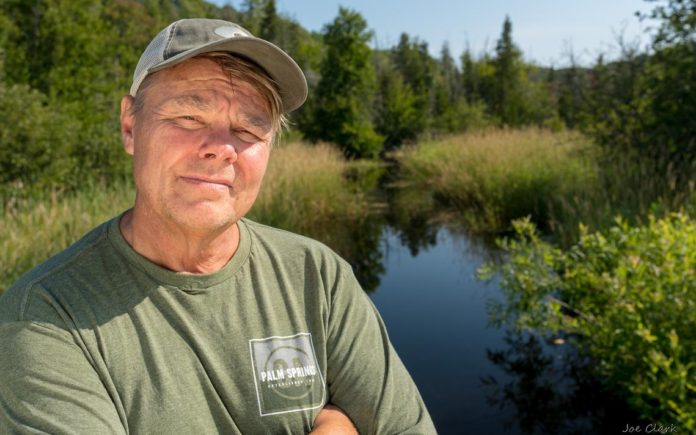Curtis DeBerg grew up in northwest Iowa, graduated from the University of Northern Iowa and spent several years working as a certified public accountant in Des Moines. After completing a Ph.D. at Oklahoma State University, DeBerg moved to Chico, California, where he taught financial accounting at California State University for 40 years.
“There are two watershed moments in my life when I knew Hemingway would be an important part of it,” DeBerg said.
The first of those moments occurred in 2004 while visiting his cousin, Laverle Vust (originally from Little Rock, Iowa), in Key West, Florida. Hemingway lived in Key West from 1928 to 1939, and the island’s tourism industry includes significant Hemingway ties. At this point, DeBerg only knew Hemingway from having read “The Old Man and the Sea,” but he became interested in the author during his time in Key West.
Once he read Michael Reynolds’s biography of Hemingway, DeBerg was officially a fan.
“This man’s life story is as interesting as his real stories,” he remembered thinking at the end of the book.
The second watershed moment wasn’t until 2016. DeBerg was vacationing in Poland, and he took a ride in a two-seat passenger lightweight aircraft. The plane crash landed, and DeBerg spent four months in the hospital after sustaining several broken bones.
While convalescing, DeBerg remembered that Hemingway had survived two plane crashes.
“I remembered that he once wrote, ‘To become a great writer, you must first endure great pain,'” DeBerg recalled.
At that point, DeBerg resolved to go to Paris, then travel the world in Hemingway’s footsteps. He spent the next five years doing just that, from Hemingway’s birthplace in Oak Park, Illinois, to his family’s summer home on Walloon Lake, northern Michigan, to the City of Lights.
During Hemingway’s tenure in Paris from 1921 to 1928, he traveled to many other places in Europe, so DeBerg went to all of them, too. Over the course of his travels, he took hundreds of pictures and hired professional photographers to accompany him to the key locations.
The Paris leg of DeBerg’s journey started last year with a sabbatical from his job. DeBerg originally intended to return to his teaching post after spending the year on Hemingway research, but when COVID-19 hit, he decided to just retire a little earlier than planned and stay in Paris.
Of all the places he’s been chasing Hemingway, DeBerg said his favorite has been Santiago de Compostela, Spain. Hemingway called the 100,000-person city “the loveliest town in Spain.”
“I couldn’t find anything about Hemingway on my walkabout town,” DeBerg recalled. “No busts or statues. I had to go to the tourism office to ask directions to what used to be Hemingway’s hotel. It’s a restaurant now; the hotel burned down years ago. I knew he stayed here a few times, with Pauline (his second wife), shortly after they were married.
“Outside the restaurant, there is a small plaque dedicated to Hemingway. When I finally found the building, I spotted the plaque, only a little larger than a license plate. Hemingway’s name is listed just below that of a Spanish author who had stayed there, too. Not even top billing, I thought. The locals were paying tribute to the home team before paying homage to the American Nobel Prize winner in 1954. Good for them.”
COVID has prevented DeBerg from visiting three key Hemingway sites: Ketchum, Idaho, where Hemingway died and is buried; Havana, Cuba, where he hunted German submarines during World War II; and Boston, Massachusetts, where the JFK Library houses his personal papers and effects.
As soon as he’s able, DeBerg intends to make pilgrimages to each of those places. In the meantime, he sent professional photographers to travel to each location and take pictures.
Slowly, a book began to take shape. Actually, two books.
DeBerg’s publisher, Tom Pero, was a fly fishing buddy of Hemingway’s son, Jack, so he was somewhat familiar with the author’s biography. Pero encouraged DeBerg to first release his photography-focused “Traveling the World with Hemingway” in June, followed by a second book next year, titled “Chasing His Demons.”
“Chasing His Demons” will chronicle the four things that tormented Hemingway throughout his life: his parents; his four wives and his own betrayal of them; pain (Hemingway was injured or sick for most of his life); and anguish (depression and alcoholism).
Although many writers have biographized the Nobel Prize winner, DeBerg believes he has a unique take on Hemingway’s life, and he’s excited to share it.
“If neither of my books would ever sell, I’d be OK with that,” DeBerg said. “I’m having the time of my life.”
When “Traveling the World with Hemingway” comes out, it will be sold at the Hemingway House in Key West, as well as everywhere else books are sold. DeBerg recommends buying it directly from the publisher, Wild River Press. The oversized 10- by 12-inch volume includes 240 full-color pages.
“Hemingway was an incredible fiction writer because he was a great liar,” DeBerg said of his subject. “The tragedy is that in the end, he couldn’t tell the difference, because he couldn’t remember.”
Credit: Source link































